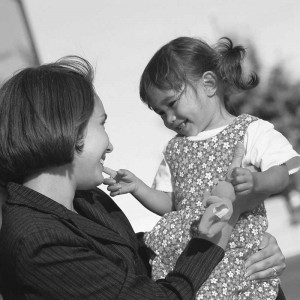Children who are non-verbal need other forms of reinforcement that do not necessarily require reciprocal interaction to increase their motivation to work at the table. Reciprocal interaction is a method children or adults use when interacting with others.

For example, if a child pretends to cut velocro fruit and offers a half to a therapist to eat, then the child is preforming a reciprocal interaction. Some children with autism may lack this and must require extra efforts from therapist’s to engage the child. Therefore, a therapist may need to really exaggerate their facial expressions as another way to show how fun reinforcement is. There will be times when a therapist will try anything to make a child smile. Therefore, it is necessary to do a reinforcement assessment to find what will make a child laugh or smile.
A reinforcement assessment is a method therapist’s use to find what is reinforcing for a child at a particular time. Therapist’s can hold out two objects or food and wait for the child to communicate which one is more desirable. A therapist can then hold up the desirable with another toy (or food) to find out which is even more reinforcing. By doing this, a therapist can find a range of reinforcers that are good, great, and to die for.
Toy reinforcers can and should be used with older children as long as it is appropriate. For example, toy helicopters, balls that light up slime and whoopee cushions are all appropriate for children over 7 years old.
For children who are chronilogically older but may be a few years behind developmentally, types of reinforcement should be taken into consideration. For example, if a child who is chronicalogically aged 8 but is deveolpmentally functioning at age 4, gross physical reinforcement should be encouraged. Examples can be jumping on a trampoline, playing tug-o-war, tickling or pillow fights. These types of reinforcements are suitable to older children and, therefore, will not cause the child to be socially isolated from his peers. At the same time, these reinforcements will be reinforcing for a child who is developmentally aged four.
Toys should also represent what the child’s Self-Stimulatory Behaviour is. If a child enjoys things that spin, then a therapist should bring spin tops, fans, and helicopters as toys a child can earn at the table.
Many toys can be purchased at a dollar or party store for reasonable prices. To avoid satiation, a therapist should think of around 3-5 different things you can do with that particular toy. For example, “goop” can be used to stretch it, wrap it around body parts, make a eye mask, bounce it, throw it at the wall or window to see what happens or roll it out on the table.
It is also important to try for communication with non-verbal children. Working on sound production, sign language, PECS, eye contact, pointing, or tapping the therapist’s hand should all be practiced during toy reinforcement and physical reinforcement.
Related posts:
- Tips on Delivering Reinforcement When giving reinforcement, a therapist must be quick, energetic, and...
- Differential Reinforcement and ABA Therapy Therapist should think of reinforcement as part of shaping a...
- How To Play Effectively With Children With Autism In the years of doing ABA, I have realized how...
Comments are closed.